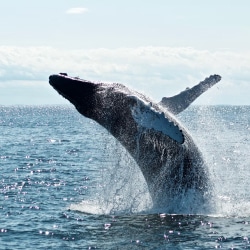Whales Eat More Than We Thought

It is a fairly simple question – how much do whales eat? Until now that question has always been answered with rough calculation, but now we can more accurately answer thanks to recent research.
Tricky to analyse
The difficulty with analysing the eating habits of baleen whales (such as humpback whales, right whales, and blue whales) is that they mostly feed deep down in the ocean, where it is hard to observe them. They also don’t necessarily feed consistently. Some species of baleen whale eat plentifully for months, but then fast for large parts of the year.
Not put off, the research team from Stanford University in the US, tracked baleen whales in the Atlantic, Pacific, and Southern Oceans. They also used drones to measure krill concentrations which is the main diet of most baleen whales.
The results, showed that whales eat much more than previously estimated. For example a blue whale eats an average of 16 tons of food every day, which is about three times more than it was thought.
Whales important for ocean ecosystem
The research also highlighted that baleen whales play a more important part in the marine ecosystem than scientists thought. There are 14 baleen whale species and they are all vital in moving nutrients such as carbon, nitrogen and iron though the ocean. Primarily they do this via their excrement.
This new knowledge only furthers our needs to protect the oceans, particularly the fragile Southern Ocean where human impact is causing waters to warm. The rising temperatures will affect the levels of krill, which will mean whales will not migrate to those waters and nutrient levels will drop as a result, dramatically affecting that ecosystem.
Past guesstimates incorrect
In the past, to estimate baleen whales food intake scientists used the eating habits of other large marine animals such as orcas and then calculated how much blue whales or humpback whales ate by multiplying by the size difference.
Obviously now that we know that whales eat far greater amounts, it is easy to dismiss this previous guesswork technique. Orca’s are very different animals to blue or humpback whales so it isn’t going to be accurate to use them as the basis of baleen whale food intake.
New calculations
The latest research involved tagging 321 whales spanning seven of the fourteen baleen species: humpback whales, blue whales, fin whales, bowhead whales, Antarctic minke whales, Bryde’s whales, and North Atlantic right whales.
The tagging equipment measured whales lunging, which is the movement they do when accelerating for food. The measurement is much like a pedometer measuring human steps. Drones also captured footage that enabled them to measure the size of the whales mouths. That then allowed the team to calculate the volume of water that is capture during each ‘lunge’. Finally sonar was used to measure the density of krill in each location, which helped determine how many of the tiny shrimp like animals the whales would swallow with each lunge.
Past estimates suggested that baleen whales ate up to 5% of their body weight in krill each day. The new research showed that they actually eat between 5 and 30% of their body weight daily.
Krill need whales
One of the interesting areas that the research highlighted was the role of the whales within the ocean ecosystem. During the early 20th Century baleen whales were aggressively hunted with some species being close to extinction. It was believed that with whale numbers declining that the numbers of krill would increase, but that wasn’t the case.
What is now clear is that the whales role within the ecosystem is not just as predator to the krill but also it provides the nutrients within their faeces to support increased phytoplankton. Phytoplankton are what krill feed on, so more phytoplankton means more krill, which means more whales.
Healthy oceans need whales to make it a nutrient rich environment.



